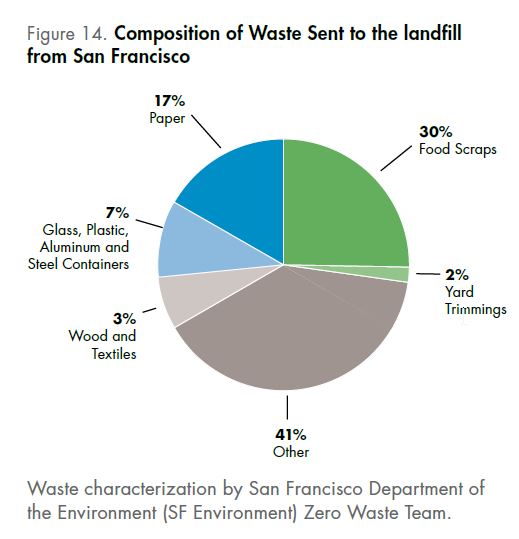
Jurisdiction: San Francisco, CA
Plan Year: 2004
Update Year: 2013
Background:
In September 2004, San Francisco Department of the Environment (SF Environment) and the San Francisco Public Utilities Commission with assistance from the International Council for Local Environmental Initiatives (ICLEI) released a forward-looking local government Climate Action Plan that includes significant measurable plans to reduce materials-related GHG emissions. In 2013, SF Environment updated the 2004 plan with the San Francisco Climate Action Strategy Update, under Mayor Edwin Lee.
The CAP recognizes the greenhouse gas benefits from avoiding the energy used during the extraction and processing of virgin raw materials to manufacture new products and that reducing landfill lowers the amount of methane released into the atmosphere.
“From food to clothes to countertops, the things we buy and materials we use take a tremendous amount of natural resources. The extraction and use of oil, gas, minerals, and water required to make things can cause a wide range of damage to our climate system.”
The 2004 report proposes a wide variety of actions to achieve its stated emissions reductions, which fall into the following categories: sustainable transportation modes, energy efficiency & renewable energy, alternative fuels, and waste reduction.
- Zero Waste by 2020
- 100% renewable electricity by 2020
- 50% sustainable trips
- 80% emissions reduction below 1990 levels by 2050. Emission reduction goals by year:
- 20% reduction by 2012
- 25% reduction by 2017
- 40% reduction by 2025
- 80% reduction by 2050
Materials Management Goals:
- Increase residential recycling and composting
- Increase commercial recycling and composting
- Expand construction and demolition debris recycling
- Promote source reduction, reuse and other waste reduction
- Support alternate collection methods for recyclable materials
Strategies:
- Banning Styrofoam and other brands of polystyrene foam in City department and for food service operators
- Banning non-compostable plastic bags
- Require events to offer recycling and composting bins
- Reduce packaging in collaboration with legislators, producers, wholesalers, retailers, and consumers
Progress Report:
- 80% waste diversion rate in 2010 (highest of any major city in North America)
- GHG emissions from waste sent to landfills decreased by almost half in 2013, compared to 1990 levels
- Overall reduction in GHG emissions of 14.5% between 1990 and 2010
- Passed Construction and Demolition Debris Recovery Ordinance in 2006
- Passed Food Service Waste Reduction Ordinance in 2006 to keep Styrofoam pollutants out of the bay, ocean, and landfills
- Achieved nearly 100% compliance
- Reduced
- Banned plastic bags at large grocery stores and retailers in 2007
- Also banned Styrofoam containers in restaurants and hotels
- In 2012, extended bag ban to apply to all retail stores and food establishments, and started charging for paper and compostable bags
- City required its department to develop annual climate action plans in 2008
- Green Building Ordinance passed in 2008
- San Francisco implemented a Mandatory Recycling & Composting Ordinance in 2009
Next Steps:
- Develop a zero waste facility
- Use anaerobic digesters to produce biogas from food scraps
- Develop secondary materials markets for recyclables, compostables, and processed derivatives
- Decrease use of disposable products
- Increase reuse, recycling, composting, and recycled content of products
Links:
